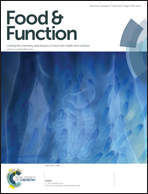Isolation of a novel lutein–protein complex from Chlorella vulgaris and its functional properties
Abstract
A novel kind of lutein–protein complex (LPC) was extracted from heterotrophic Chlorella vulgaris through aqueous extraction. The purification procedure contained solubilization of thylakoid proteins by a zwitterionic detergent CHAPS, anion exchange chromatography and gel filtration chromatography. Both wavelength scanning and HPLC analysis confirmed that lutein was the major pigment of the protein-based complex, and the mass ratio of lutein and protein was determined to be 9.72 : 100. Besides showing lipid peroxidation inhibition activity in vitro, LPC exerted significant antioxidant effects against ABTS and DPPH radicals with IC50 of 2.90 and 97. 23 μg mL−1, respectively. Meanwhile, in vivo antioxidant activity of the complex was evaluated using the mice hepatotoxicity model; LPC significantly suppressed the carbon tetrachloride-induced elevation of serum alanine aminotransferase (ALT) and aspartate aminotransferase (AST) activities, and decreased hepatic malondialdehyde (MDA) levels and the hepatosomatic index. Moreover, LPC could effectively restore the activities of superoxide dismutase (SOD), catalase (CAT) and glutathione peroxidase (GSH-Px) in the treated mice livers. Our findings further the progress in the research of natural protein-based lutein complexes, suggesting that LPC has the potential in hepatoprotection against chemical induced toxicity and in increasing the antioxidant capacity of the defense system in the human body.


 Please wait while we load your content...
Please wait while we load your content...